Lesson 1: Follow The Two Track Method
Reading: Read content other than video.
Let’s start. Follow the two-track approach. Now, there is one thing you need to understand, and that is whenever we talk about the two-track approach, we are referring to pseudocode along with program code. The program code is completed in any programming language.
What does Cambridge University say about the two-track method? It states that students are advised to program solutions to a variety of computer problems on a computer using one of the high-level languages, which include Python, VB.NET, and Java. Here, I want to make one thing clear, and that is.
Often, teachers tell you that just learning pseudocode is enough. However, Cambridge University requires you to learn logic, and the most important thing for learning logic is that you run both elements in parallel from the very first day—pseudocode and programming code.
In pseudocode, you will define the task, and in the same pattern, you will generate and run the code in your selected programming language. This will help you build a strong logical foundation for yourself.
Before we move on to the new lecture, the final advice.
Students should follow both pseudocode and programming code methods to develop a strong understanding of problem-solving. Pseudocode helps in structuring logic in a language-independent manner, while programming code allows them to implement and test their solutions practically. Cambridge University emphasizes the importance of learning logic through both approaches simultaneously. By practicing both from the very first day, students can improve their logical reasoning and problem-solving skills, which are essential for securing good grades.
Press the “Mark as Complete” button to finish the lecture.

